Menu
- Sign-In
- Sign-Up
Electric floor heating mats are engineered for superior comfort, wellness, and sustainability.
As featured in:







Are you looking for a heating solution that is not only energy-efficient but also provides ultimate comfort? Look no further than electric radiant floor heating systems like STEP HEAT.

Electric floor heaters, like those in our STEP HEAT range, are 30-60% more efficient than traditional line radiant cable/mat systems and hydronic radiant systems.

With AC or DC power options, our underfloor heating electric systems can connect to alternative energy now, or at any time in the future.

Reduces dry air, dust, allergens, and other harmful airborne particles circulated by traditional systems.

From hardwood floors to carpets, STEP HEAT is compatible with almost any flooring type.
Say goodbye to maintenance headaches and hello to net-zero heating with our electric radiant heat mats. Don’t wait any longer to experience the benefits of STEP HEAT. Upgrade your heating system today and start saving on your energy bills while enjoying ultimate comfort.
STEP HEAT features the greatest floor area coverage of any radiant system. With designs covering an average of 50-60% of the floor area, heat is evenly distributed across the entire room. The increased coverage reduces the creation of cold spots while STEP HEAT’s self-regulating ability prevents hot spots, ensuring an evenly distributed, soft warmth, right where you want it.
STEP HEAT’s increased surface area coverage has another benefit, it allows the system to use less energy by operating at a lower temperature. Other radiant heating systems overcompensate for their lack of surface area by heating to temperatures as high as 130°. A Typical STEP HEAT design operates at 81°F, nearly 50° less than other systems!

Unlike traditional heating systems, STEP HEAT does not use forced air to distribute heat. The heating elements transfer heat through radiation, creating an even and comfortable warmth throughout your home while reducing the circulation of dust, allergens, and other particles that can negatively affect indoor air quality and exacerbate respiratory problems. By promoting a healthier indoor environment, STEP HEAT can help to improve overall well-being and reduce the risk of respiratory illnesses.

Whether AC or DC current, line or low voltage, STEP HEAT’s design flexibility provides multiple powering options depending upon source availability, application, and total load requirements.
Sources include alternative energy such as Wind, Solar, and Hydro Power as well as Storage Batteries, Generators, and various Grid provided line voltages.
STEP HEAT is certified by Greener Product® which verifies the product complies with the LEED, LEED for Homes and NAHB standards. STEP HEAT qualifies for credits in the following LEED categories:

STEP HEAT’s heating element technology ensures that you never use more energy than you need. Unlike any other heating system, STEP HEAT’s heating elements have the ability to self-regulate. Each heating element acts like a temperature sensor, continuously adjusting its output to changing room temperatures at all points across the heated area.
How it works:
When the heating elements are colder, the particles are closer together which allows for higher heating output. When the heating elements are warmer, the particle seperate which results in lower heating output.
The result:


The wait for an efficient electric heating system is finally over. Powered by just 24 volts, the STEP HEAT system is 2.5X more efficient than electric cable and hydronic radiant heating systems. Reduce your carbon footprint while enjoying the world’s most comfortable heating experience.
Our radiant underfloor heating system turns your entire floor into a temperature sensor. When the temperature in one area of the room changes, STEP HEAT will reduce or increase its output as needed. Laying on the floor? The system will sense the presence of your body heat and reduce its energy output underneath you, keeping you comfortable while reducing your energy costs.





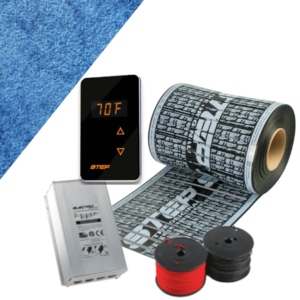
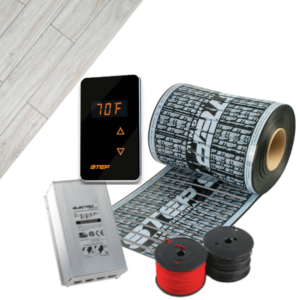
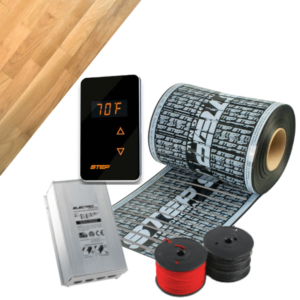
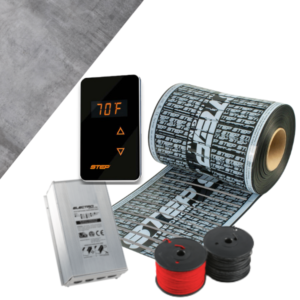
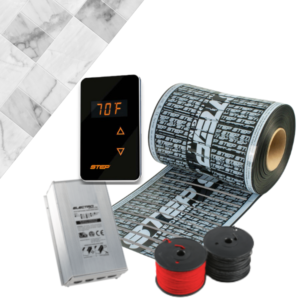





Heat mats can last anywhere from 30-50 years, as they don’t have worn parts or mechanical failings like conventional heating systems. This long lifespan is supported by a minimum warranty period of twenty years.
It’s recommended not to abruptly turn the heating mats on and off, especially in homes with wood floors, to avoid stress fractures and warping. The advised approach is “Set It and Forget It,” utilizing smart control for temperature adjustments.
Yes, heated floor mats are compatible with laminate flooring and most other types of floor. They are self-regulating to prevent overheating and maintain the integrity of the flooring. Proper non-conductive underlay and thermal insulation are required during installation.
Yes, underfloor heating is generally cheaper to run than radiators, offering significant long-term savings and a high return on investment. A free comparative heat loss and consumption analysis are available to forecast anticipated savings.
Heating mats for floors are not a fire hazard due to their low voltage system and self-regulating nature. They have a 24V Safe Extra Low Voltage (SELV) rating and are suitable even in wet areas.
The main downside is the higher initial installation cost compared to traditional heating systems. However, this cost is often offset by long-term savings in operating costs, efficiency, and lack of maintenance.
The installation cost varies based on house design, power supply locations, wiring method, area labor rates, and trade installer types. Installation estimating tools are available upon request for potential viability assessment.
Heat mats are energy-efficient, using significantly less electricity compared to other heating systems. A consumption analysis comparison is available for specific applications.
A typical design output for floor warming or supplemental heat is 4.5-5 watts per square foot, sufficient for primary heating in newer homes built to current energy codes. A heat loss analysis is essential for primary heating requirements.
The best underfloor heating mats should feature low-voltage electricity, self-regulating carbon polymer heating technology, and be alternative energy-ready.
